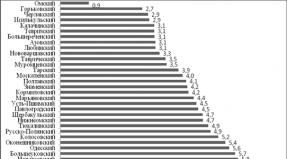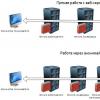Betalok - Cardooselective drug. Betalok® Intravenous Intravenment Solution Application during pregnancy or breastfeeding
Betalok can be prescribed in combination with β2-agonists to patients with COPD. In the therapeutic doses of betal in combination with β2 agonists, a lesser extent affects the tone of the bronchi compared to non-selective β-adrenoreceptor blockers.
Betalki to a lesser extent affects the release of insulin and the metabolism of carbohydrates than non-selective blockers β-adrenoreceptors.
Influence of the drug of betal in the reaction of cardio-vascular system Under hypoglycemia, it is significantly less pronounced than non-selective β-adrenoreceptor blockers.
Betalki may cause a slight increase in the level of TG and reducing the levels of free fatty acids in the blood serum. In some cases, a slight decrease in the levels of HDL was noted.
The introduction of metoprolol with myocardial infarction allows to reduce the severity of pain syndrome, reduce the frequency of fibrillation and atrial fibrillation. An early start of therapy (within 24 hours after the appearance of the first symptoms) allows you to prevent the spread of necrosis and limit the infarct zone.
After a / in infusion, metoprolol is quickly distributed (for 5-10 minutes). When applied at a dose of 5-20 mg, pharmacokinetics linear. Metoprolol is metabolized in the liver, while three metabolites are formed without a single clinically significant effect of β-adrenoreceptor blockers. The half-life is about 3.5 hours (1-9 h). Only 5% of metoprolol is removed with urine unchanged, the rest is in the form of metabolites.
Patients of elderly, the pharmacokinetics of metoprolol does not change. The systemic bioavailability and the rate of removal of metoprolol does not change in patients with kidney pathology, but the rate of metabolites is reduced, which has no clinical value.
Given the low degree of binding with plasma proteins, the violation of the liver function does not affect the pharmacokinetics of metoprolol. But in patients with severe liver cirrhosis or shunting portal veins, the removal of metoprolol is reduced.
Betalok V / B - Indications for use
supportmentaricular tachyarhythmia; Myocardial Ischemia, Tahiaritmia and painful syndrome due to myocardial infarction.Contraindications
AV blockade II or III degree; acute or chronic heart failure in the decompensation stage (pulmonary edema, hypoperfusion or hypotension syndrome); Inotropic therapy (continuous or periodic), therapy aimed at stimulating β-adrenoreceptors; sinus bradycardia, Sine node weak syndrome, cardiogenic shock, severe impaired peripheral blood circulation. Metoprolol should not be prescribed to patients with suspicion of acute myocardial infarction, if the heart rate is lower than 45 ° C. / min, interval R-Q more than 0.24 s, and systolic hellCautions when used
patients receiving β-adrenoreceptor blockers should not be introduced in / in calcium antagonists like verapamil. As a rule, the agonists of β2-adrenoreceptors (tablets and / or aerosol) are prescribed patients with BA as concomitant therapy. In such cases, at the beginning of the treatment of betal, it may be necessary to increase the dose of agonist β2-adrenoreceptors.During the treatment of Betalki, the risk of impaired carbohydrate exchange or masking symptoms of hypoglycemia is lower than in the treatment of non-selective β-adrenoreceptor blockers.
In patients with chronic heart failure, a disease compensation should be made before the start of therapy by Betalok, and during its application, continue the preparations of basic therapy.
Very rare in patients with violation of AV conduction middle degree Could note complications (AV blockada). If a bradycardia arose against the background of treatment, the dose of Betalok needs to be reduced or gradually cancel the drug.
Betalki can strengthen the symptoms of the impaired peripheral blood circulation mainly due to the decline in blood pressure.
Patients with a peochromocytoy simultaneously with the preparation of betal should be defined by α-adrenoreceptor blockers.
In the case of surgical intervention, it is necessary to warn anesthesiologist that the patient takes betalki, but it is not recommended to stop treatment with β-adrenoreceptor blockers.
The abolition of the drug is carried out gradually for at least 2 weeks; Sharp cancellation is invalid. The dose must be reduced twice at each stage until the achievement daily dose 25 mg. During this period, patients, especially with IBS, should be under constant medical supervision. During the abolition of the drug, the risk of coronary disorders increases, including sudden death.
In patients receiving β-blockers, anaphylactic shock is heavier.
Patients who have blood pressure
In the treatment of patients with suspected or confirmed myocardial infarction, it is necessary to carefully monitor hemodynamic parameters after each B / in the introduction of 5 mg of betaloca. The second or third of the introduction of the Betalok should not be carried out if the heart rate
During pregnancy and breastfeeding
Like other drugs, betalok should not be prescribed during the period of pregnancy and breastfeeding, except in cases where the use of betaloca is vital. Like all antihypertensive drugs, β-adrenoreceptor blockers can cause undesirable phenomena, such as bradycardia by the fetus, a newborn or baby breastfeeding. The amount of metoprolol entered into breast milk does not affect the blockers of the child's β-adrenoreceptors.
Impact on the ability to manage vehicles and work with potentially dangerous mechanisms
The patient should be aware of his reaction to the treatment of betal, since such phenomena as dizziness and weakness are possible.
Medicinal interaction
patients must be under medical controlif, simultaneously with the preparation of betal, gangliplockers, other β-adrenoreceptor blockers (for example, eye drops) or monoaminoxidase inhibitors (I-MAO).If you need to cancel the concomitant treatment with clonidine, the β-adrenoreceptor blocker should be canceled a few days before the cancellation of the clonidine.
In patients who receive a verapamiloic type calcium antagonists simultaneously and / or preparations for the treatment of arrhythmias, negative foreign and chronotropic effects are possible, and the appointment with such patients with verapamil is contraindicated due to the threat of heart stop. Blockers β-adrenoreceptors can enhance the negative foreign and chronotropic effects of preparations for the treatment of arrhythmia (Analogs of quinidine or amiodar).
In patients receiving balconies β-adrenoreceptors, inhalation anesthetics enhance the cardiodepressive effect. Inductors or metabolism inhibitors can affect the concentration of metoprolol in the blood plasma, which is reduced when taking rifampicin and can increase when taking cimetidine, alcohol, hydraulosine and inhibitors of serotonin inverse (steamsetin, fluoxetine and sertralin).
With concomitant treatment with indomethacin or other drugs inhibiting prostaglandin synthetase, antihypertensive effect Blockers β-adrenoreceptors can decrease. Cardooselective blockers of β-adrenoreceptors are significantly less influenced by adrenaline patients with adrenaline patients than non-selective β-adrenoreceptor blockers.
With a concomitant reception of β-adrenoreceptor blockers, the dose correction of oral antidiabetic agents may be needed.
Betalki B / B - Application and Dosage Method
parenteral administration of Betalok should conduct specially trained personnel in the presence of cardioresis monitoring and the possibility of resuscitation activities.Supported Tahiaritmia
The initial dose of the drug is 5 mg (5 ml of r-ra), the rate of infusion is 1-2 mg / min. In such a dose, the drug can be administered every 5 minutes before achieving the necessary effect. As a rule, 10-15 mg (10-15 ml of r-ra) is sufficient to achieve the desired effect. The maximum dose for in / in administration is 20 mg (20 ml of R-ra).
Treatment of myocardial and pain syndrome due to myocardial infarction
With uncomplicated states, the initial dose is 5 mg (5 ml of r-ra) in / c. The introduction of the drug can be repeated every 2 minutes, maximum dose It is 15 mg (15 ml of r-ra). After 15 minutes, after the latter, the introduction must be prescribed inward 50 mg of metoprolol Tartrate every 6 hours for 2 days. For long-term treatment, a tablet of metoprolol should be prescribed (for example, Betal Zock, slow-release tablets).
Application in patients with renal failure
In case of kidney disease, there is no need for a dose correction.
Application in patients with hepatic insufficiency
Typically patients with liver cirrhosis, the dose correction is not carried out; In the event of severe liver function, there may be a need to reduce the dose.
Application in senior patients
In the reduction of the dose there is no need.
Application in children
The experience of using the drug of beta flies for injections in children is limited.
Side effects
usually Betalok suffer well. Sideflines insignificant and reversible. When using the preparation of Betalki, such side effects were reported:From the side of the cardiovascular system: often - bradycardia, postural disorders (very rarely - loss of consciousness), cold limb, feeling of reinforced heartbeat, strengthening symptoms of heart failure, AV blockade, swelling, heart pain; rarely - heart violations, arrhythmia, swelling; Very rarely - gangrene in patients with severe peripheral circulatory disorders.
From the CNS: fatigue, dizziness, headache; Sometimes - paresthesia, cramps.
From the gastrointestinal tract: nausea, abdominal pain, diarrhea, constipation; Rarely - vomiting, dry mouth.
From the side of the blood system: very rarely thrombocytopenia.
Liver: rarely - deviations of hepatic indicators; Very rarely - hepatitis.
From side bone-muscular system: Very rarely - arthralgia.
From the metabolism: an increase in body weight.
Mental status: Sometimes depression, weakening the concentration of attention, drowsiness or insomnia, nightmares; Rarely - nervousness, anxiety, very rarely - amnesia / violation of memory, confusion, hallucinations.
From the respiratory authorities: shortness of breath exercise; Sometimes - bronchospasm; Rarely rhinitis.
From the side of the senses: rarely - impairment of vision, dryness and / or eye irritation, conjunctivitis; Very rarely - noise in the ears, violations of taste.
From the skin: rash, high sweating, hair loss; Very rarely - photosensibilization, exacerbation of psoriasis.
Others: Impotence / Sexual dysfunction.
Overdose
Symptoms: severe hypotension, sinus bradycardia, AV blockade, heart failure, cardiogenic shock, cardiac arrest, bronchospasm, violation of consciousness, coma, nausea, vomiting and cyanosis. The simultaneous use of alcohol, drugs to reduce blood pressure, chinidine or barbiturates can complicate the patient's condition.Treatment: symptomatic therapy. With severe hypotension, bradycardia and heart failure, β1-adrenoreceptor stimulants are prescribed (for example, prealterone) in / in with an interval of 2-5 minutes or in the form of infusion until the desired effect is achieved. In the absence of β1-adrenoreceptor stimulants, dopamine can be applied; For blockade wandering nerve Apply to / in atropine sulfate. If the desired effect is not reached, other sympathomimetics are used, such as dobutamine or norepinephrine, prescribe glucagon at a dose of 1-10 mg. It may be necessary to apply the driver heart Rhythm. In the event of bronchospasm, it is introduced into / in β2-adrenoreceptor stimulants. It should be remembered that the doses of drugs (antidotes) necessary for the treatment of overdose by the β-adrenoreceptor blockers should be higher therapeutic, since β-adrenoreceptors are engaged in their blocker.
name of the drug
Registration number: LSR-001402 / 07-151214
Trade name: Betalok®
International unpatient name: metoprolol
Dosage form: Solution for intravenous administration
Structure
1 ml of solution contains
Active substance: 1 mg metoprolol Tartrate for injection
Auxiliary substances: sodium chloride for injection of 9 mg, water for injection up to 1 ml.
Description
Transparent, colorless liquid.
Pharmacotherapeutic Group: Beta 1-adrenoblocator selective.
ATH code - C07 AI B02
Pharmacological properties
Pharmacodynamics
In patients with myocardial infarction, intravenous administration of metoprolol reduces the pain in the chest and reduces the risk of flickering and atrial flutter. Intravenous administration of metoprolol at the first symptoms (within 24 hours after the appearance of the first symptoms) reduces the risk of developing myocardial infarction. The early start of treatment by metoprolol leads to an improvement in the further forecast of the treatment of myocardial infarction.
It achieves a decrease in heart rate (heart rate) with paroxysmal tachycardia and flickering (trepidation) atrial.
Metoprolol - β1-adrenobloclocator, blocking β1 receptors in doses of significantly smaller than the doses required to block β2 receptors. Metoprolol has a minor membrane-stabilizing effect and does not show the activity of a partial agonist. Metoprolol reduces or inhibits an agonistic effect, which is provided on the heart activities of catecholamines formed with nervous and physical stresses. This means that metoprolol has the ability to impede an increase in the frequency of heart abbreviations, minute volume and strengthening of myocardial reductions, as well as the rise in blood pressure (AD) caused by a sharp emission of catecholamines.
Patients with symptoms of obstructive pulmonary diseases can be prescribed metoprolol in combination with β2-adrenomimetics. When combined with β2-adrenomimetics of Betalok®, in therapeutic doses, to a lesser extent affects the brutalized by β2-adrenomimetics, than non-selective β-adrenoblays.
Metoprolol to a lesser extent than non-selective β-adrenoblays affects insulin products and carbohydrate exchange. The effect of the preparation of Betalk® on the reaction of the cardiovascular system under hypoglycemia conditions is significantly less pronounced compared to non-selective β-adrenoblockers.
Improving the quality of life in the treatment of Betalo® was observed in patients after myocardial infarction.
Pharmacokinetics
Metoprolol is subjected to oxidative metabolism in the liver with the formation of three main metabolites, none of which has a clinically significant β-blocking effect.
About 5% of the adopted dose is displayed with urine unchanged.
The average half-life of metoprolol from blood plasma is about 3-5 hours.
Indications for use
Supported tachycardia.
Prevention and treatment of myocardial ischemia, tachycardia and pain in myocardial infarction or suspicion of it.
Contraindications
Atrioventricular blockade of the II and III degree, heart failure in the stage of decompensation, constant or intermittent therapy by inotropic drugs acting as beta adrethrenimetics, clinically significant sine bradycardia, sinus-node weak syndrome (with the exception of patients with a permanent rhythm driver), cardiogenic shock, severe violations Peripheral blood circulation, including in the threat of gangrenes, arterial hypotension.
Betalok® is contraindicated in patients with suspicion of acute myocardial infarction at heart rate less than 45 shots per minute, PQ interval more than 0.24 seconds or systolic arterial pressure Less than 100 mm Hg.
Well-known increased sensitivity to metoprolol and its components or other β-adrenoblockers.
In the treatment of hydrodynricular tachycardia in patients with systolic arterial pressure less than 110 mm Hg.
Patients receiving β-adrenoblocators are contraindicated with intravenous administration of "slow" calcium channels of the verapamil type.
Age up to 18 years (efficiency and security are not established).
Carefully: Atrioventricular blockade of I degree, angina printela, chronic obstructive pulmonary disease (lung emphysema, chronic obstructive bronchitis, bronchial asthma), diabetes, severe renal failure.
Application during pregnancy and in breastfeeding period
Pregnancy
Like most drugs, Betalk® should not be prescribed during pregnancy and in the period breastfeedingExcept in cases where the expected benefit for the mother exceeds the potential risk to the fetus. β-adrenobloclars reduce placental blood flow, which can lead to a delay of intrauterine development, intrauterine fetal death, spontaneous miscarriage and premature childbirth. In the case of the use of Betalok® drug during pregnancy, it is recommended to conduct appropriate observation of the patient and fetus state. Like other hypotensive drugs, β-adrenoblays can cause side effects, for example, bradycardia in the fetus, newborns or children located on
breastfeedingIn connection with which it should be especially careful when appointing β-adrenobloclars in the last trimester of pregnancy and immediately before childbirth.
Period of breastfeeding
The amount of metoprolol, released into breast milk, and β-adrenoblocking effect in a child in breastfeeding (when taking a metoprolol mother in therapeutic doses), are insignificant.
Method of application and dose
Supported Tachycardia
The introduction of C 5 mg (5 ml) of the Betalki® preparation is beginning at a speed of 1-2 mg / min. You can repeat the introduction with a 5-minute interval before reaching therapeutic effect. Typically, the total dose is 10-15 mg (10-15 ml). Recommended maximum dose when intravenous administration is 20 mg (20 ml).
Prevention and treatment of myocardial ischemia, tachycardia and pain in myocardial infarction or suspicion of it
Intravenously 5 mg (5 ml) of the drug. You can repeat the introduction with a 2 minute interval, the maximum dose is 15 mg (15 ml). After 15 minutes after the last injection, metoprolol is prescribed for reception in a dose of 50 mg (Betalk®) every 6 hours for 48 hours.
Violation of kidney function
No need to adjust doses in patients with impaired kidney function.
Violation of the liver function
Usually due to the low degree of connection with plasma proteins, the dose correction is not required. However, with severe violation of the liver function (in patients with portocal anastomy), a dose reduction may be required.
Elderly age
There is no need to adjust the dose in older patients.
Children
The experience of using the preparation of Betalk® in children is limited.
Side effect
Betalok® is well tolerated by patients, and side effects are mostly light and reversible.
As a result clinical studies or when using the preparation of Betalk® (metoprolol Tartrate) in clinical practice The following undesirable side effects were described. In many cases, the causal relationship with the treatment of Betalk® was not installed. The following criteria were used to estimate the frequency of cases:
Very often (\u003e 10%), often (1-9.9%), infrequently (0.1-0.9%), rarely (0.01-0.09%) and very rarely (<0,01%).
From the cardiovascular system
Often: Bradycardia, postural disorders (very rarely accompanied fainting), feeling of coldness of the limbs, feeling of heartbeat.
Infrequently: temporary strengthening of heart failure symptoms, cardiogenic shock in patients with acute myocardial infarction, an atrioventricular blockade of I degree, swelling, pain in the heart.
Rarely: other conductivity disorders, arrhythmias.
Very rarely: gangrena in patients with preceding severe peripheral circulatory disorders.
From the central nervous system
Very often: Increased fatigue.
Often: dizziness, headache.
Infrequently: paresthesia, convulsions, aggravation of the flow of depression, a decrease in the concentration of attention, drowsiness or insomnia, nightmares.
Rarely: increased excitability, anxiety.
Very rarely: amnesia / memory disorders, state of depression, hallucinations.
From the digestive system
Often: nausea, pain in the abdomen, diarrhea, constipation.
Infrequently: vomiting.
Rarely: dry mouth mucous membrane, liver function disorders.
Very rarely: hepatitis.
From the side of the skin and subcutaneous fabrics
Infrequently: rash (in the form of urticaria), increased sweating.
Rarely: Alopecia.
Very rarely: photosensibilization, aggravation of the flow of psoriasis.
From the respiratory system
Often: shortness of breath with load.
Infrequently: bronchospasm in patients with bronchial asthma.
Rarely: rhinitis.
From the senses
Rarely: violations, dryness and / or eye irritation, conjunctivitis.
Very rarely: ringing in the ears, violations of taste sensations.
From the metabolism
Infrequently: increase in body weight.
From the skeletal muscular system
Very rarely: arthralgia.
From blood
Very rarely: thrombocytopenia.
Others
Rarely: Impotence / Sexual dysfunction.
Overdose
Symptoms
In case of overdose, a pronounced decrease in blood pressure, sharp heart failure, bradycardia, bradyarithmia, violation of intracardiac conductivity and bronchospasm.
Treatment
Treatment should be carried out in a medical facility, which has equipment and conditions for maintaining the vital activity and monitoring of the patient's condition.
In bradycardia and violation of conductivity, atropine and adrenomimetics are used, if necessary, an artificial rhythm driver is installed.
With a pronounced decrease in blood pressure, acute heart failure and shock, it is necessary to carry out therapy aimed at an increase in the volume of circulating blood plasma; apply glucagon in the form of injection (then, if necessary, introduce glucagon in the form of intravenous infusion); intravenously introduced adrenomimetics (such as dobutamine) together with α1-adrenomimetics in the event of the appearance of symptoms of vasodilation. It is also possible intravenous administration of drugs containing calcium ions.
To relieve bronchospasm, bronchi-dialectors should be applied.
Interaction with other drugs and other types of interaction
Betalk® preparation should be avoided with the following drugs:
Barbituric acid derivatives: barbiturates (the study was carried out with phenobarbital) slightly enhance metoprolol metabolism, due to induction of enzymes.
Propapanen: When prescribed a conpaphenone with four patients receiving treatment with metoprolol, an increase in the plasma concentration of metoprolol was noted 2-5 times, while two patients noted side effects characteristic of metoprolol. This interaction was confirmed during the study by 8 volunteers. Probably, the interaction is due to the inhibitory of the propaphenone, like the chinidine, metabolism of metoprolol through the cytochrome R4502D6 system. Taking into account the fact that the proppanone has the properties of the β-adrenoblocker, the sharing of metoprolol and the proppanone is not appropriate.
Verapamil: The combination of β-adrenobloclockers (atenolol, propranolol and pindolol) and verapamil may cause bradycardia and lead to a decrease in blood pressure. Verapamil and β-adrenobloclars have a complementary effect on an inhibitory effect on atri-ventricular conductivity and the function of the sinus node.
The combination of Betalk® preparation with the following drugs may require a dose correction:
Antiarrhythmic agents I class: antiarrhythmic agents I class and β-adrenobloclars can lead to summation of a negative inotropic effect, which can lead to serious hemodynamic side effects in patients with impaired left ventricular function. There should also be avoided by a similar combination in patients with a sinus node weak syndrome and an atrioventricular conduction disorder. The interaction is described on the example of dyspeyramide.
Amyodaron: The joint use of amiodarone and metoprolol can lead to severe sinus bradycardia. Taking into account the extremely long period of half-life amiodarone (50 days), it should take into account the possible interaction after a long time after the cancellation of amiodarone.
Diltiazem: Diltialand and β-adrenoblays mutually enhance the inhibitory effect on the atrioventricular conductivity and the function of the sinus node. With a combination of metoprolol with diltiazem, cases of pronounced bradycardia were noted.
Non-steroidal anti-inflammatory drugs (NSAIDs): NSAIDs weaken the antihypertensive effect of β-adrenobloclars. This interaction is most documented for indomethacin. The described interaction for Sulindaka has not been noted. In studies with diclofenas described, the reaction was not noted.
DiPhenhydramine: DiPhenhydramine reduces metoprolol clearance to α-hydroxymetoprolol 2.5 times. At the same time, an increase in the action of metoprolol is observed.
Epinephrine (adrenaline): 10 cases of pronounced arterial hypertension and bradycardia in patients who have taken non-selective β-adrenoblays (including pindolol and propranolol) and epinephrine (adrenaline) have been reported. The interaction is also noted in the group of healthy volunteers. It is assumed that such reactions may be observed when applying epinephrine together with local anesthetics in case of random hit in the vascular direction. It is assumed that this risk is much lower when applying cardiolective β-adrenobloclars.
Phenylpropanolamine: Phenylpropanolamine (Norefedrine) in a single dose of 50 mg can cause an increase in diastolic blood pressure to pathological values \u200b\u200bin healthy volunteers. Propranolol mainly prevents the heap caused by phenylpropanolamine. However, β-adrenobloclars can cause the reaction of paradoxical arterial hypertension in patients receiving high doses of phenylpropanolamine. Several cases of the development of a hypertensive crisis against the background of adhesive phenylpropanolamine were reported.
County: County inhibits metoprolol metabolism in a special group of rapid hydroxylation patients (in Sweden approximately 90% of the population), causing mainly a significant increase in the plasma concentration of metoprolol and the increase in the β-blockade. It is believed that such interaction is characteristic of other β-adrenobloclars in the metabolism of which is involved in cytochrome P4502D6.
Clonidine: Hypertensive reactions with a sharp cancellation of the clonidine can be enhanced with the joint adrets of β-adrenobloclars. With co-use, in the event of the cancellation of the clonidine, the cessation of the reception of β-adrenobloclars should be started a few days before the cancellation of the clonidine.
Rifampicin: Rifampicin can enhance metoprolol metabolism, reducing the plasma concentration of metoprolol.
The concentration of metoprolol in blood plasma can be increased by combined use with cimetidine, hydralazine, selective inhibitors of serotonin reverse seizure, such as paroxetine, fluoxetine and sertraline. Patients simultaneously taking metoprolol and other β-adrenoblays (eye drops) or monoaminoxidase inhibitors (MAO) must be under thorough observation. Against the background of receiving β-adrenoblockers, inhalation anesthetics enhance the cardiodepressive effect. Against the background of acceptance of β-adrenoblockers, patients receiving oral hypoglycemic agents may require a dose correction of the latter. Cardiac glycosides with joint use with β-adrenoblockers can increase the time of atrioventricular conduction and cause bradycardia.
special instructions
Patients receiving β-adrenoblays should not be administered intravenously blockers "slow" calcium channels of the verapamila type.
Patients with bronchial asthma or chronic obstructive pulmonary disease must be appointed by the accompanying therapy β2-adrenomimetics. If necessary, a dose of β2-adrenomimetics should be increased. When using β1-adrenoblockers, the risk of their influence on the carbohydrate exchange or the possibility of masking symptoms of hypoglycemia is significantly less than when using non-selective β-adrenoblastors.
In patients with chronic heart failure in the decompensation stage, it is necessary to achieve the stage of compensation as before and during treatment with the drug.
Patients with the walls of the printela are not recommended to assign non-selective β-adrenoblays.
Very rarely in patients with imparation of atrioventricular conductivity may be deterioration (possible outcome is an atrioventricular blockade). If against the background of treatment, bradycardia developed, the dose of Betalk® drug should be reduced. Metoprolol can enhance the impaired peripheral blood circulation mainly due to the decrease in blood pressure. Care should be exercised when prescribing to patients with severe renal failure, with metabolic acidosis, joint appointment with cardiac glycosides. In patients receiving β-adrenoblays, anaphylactic shock occurs in a more severe form. Patients with Feochromocytoy simultaneously with the preparation of Betalok® should be assigned alpha-adrenoblays. In the case of surgical intervention, an surgeon / anesthesiologist should be informed that the patient takes a β-adrenoblocator. It is not recommended to cancel the therapy by the β-adrenoblocator before carrying out the operation. In patients with risk factors for the development of cardiovascular diseases, the prescription of high doses of metoprolol should be avoided, without preliminary dose titrations in surgical interventions (with the exception of heart operations), due to the risk of bradycardia, arterial hypotension and stroke, including Exodus.
In the event that systolic blood pressure below 100 mm Hg. Art., Betalk® should be administered intravenously only when complying with special precautions due to the risk of developing a more pronounced reduction in blood pressure (for example, in patients with arrhythmias).
In the treatment of patients with myocardial infarction or suspicion, it is necessary to evaluate the basic parameters of hemodynamics after each administration of the drug at a dose of 5 mg (see section "Method of application and dose").
It should not be prescribed a re-dose - the second or third with the frequency of heart rate of less than 40 ° C. / min, the interval of PQ is more than 0.26 seconds. and systolic arterial pressure of less than 90 mm Hg. Art., as well as when strengthening shortness of breath or the appearance of cold sweat.
Impact on the ability to control vehicles and other mechanisms
Evaluation of the effect of Betalok® drug with intravenous introduction to the ability to control vehicles and other mechanisms was not studied.
Form release
Solution for intravenous administration of 1 mg / ml. 5 ml in ampoules from a colorless boron silicate glass with a notch. 5 ampoules in a plastic retainer in a cardboard pack with instructions for use.
On the ampoule above the notch is a color point, put in paint; Two colored rings are applied above the point.
Storage conditions
In a place protected from light, at temperatures below 25 ° C. Keep out of the reach of children.
Shelf life
5 years. Do not use after the expiration date.
Conditions of vacation from pharmacies
On prescription.
The name and address of the legal entity, in the name of which the registration certificate was issued
Astraseneca AB, SE-151 85 Constructore, Sweden
Manufacturer
Astrazeneca AB, Sweden, SE-151 85 Sodertalje, Sweden
Machining quality control
1. Astraseneca AB, SE-151 85 Konutore, Sweden
Astrazeneca AB, Sweden, SE-151 85 Sodertalje, Sweden
2. Senexi, France, 52 Ru Marseil E Jacques Goshe, 94120 Phontena Su Bois, France
Cenexi, France, 52 Rue Marcel et Jacques Gaucher, 94120 FONTENAY SOUS BOIS, FRANCE
Additional information is available on request:
Representative office of Astraseneca Yuk Limited, United Kingdom, in Moscow and LLC Astraseneca Pharmacyukyls
125284 Moscow, ul. Running d. 3 p. 1.
tel. +7495 7995699.
Fax +7495 7995698.
Betalka® - Trademark, property of Astrasenec.
Pharmacokinetics
Metoprolol is subjected to oxidative metabolism in the liver with the formation of three main metabolites, none of which does not have a clinically significant B-blocking effect.
About 5% of the adopted dose is displayed with urine unchanged.
The average half-life of metoprolol from blood plasma is about 3-5 hours.
Pharmacodynamics
Metoprolol is a competitive beta-adrenoreceptor antagonist. It advantageously inhibits the activity of beta-adrenoreceptors (providing some cardiodelectivity), deprived of the inner sympathomimetic activity (partial agonist activity) and has the activity of blocking beta-adrenoreceptors, comparable by power with propranolol.
A characteristic feature of metoperolol is a negative chronotropic effect on the heart. Thus, after a single reception, the volumetric speed of blood flow of the heart and systolic pressure are quickly reduced.
In patients with myocardial infarction, intravenous administration of metoprolol reduces the pain in the chest and reduces the risk of flickering and atrial flutter. Pain relief may also reduce the need to use opioid analgesics.
Metoprolol showed a decrease in mortality when applying in patients with acute myocardial infarction.
Indications for use
Supported Tachycardia
Prevention and treatment of myocardial ischemia, tachycardia and pain
myocardial infarction or suspicion of it.
Method of application and dose
The parenteral use of the preparation of betlocks should be monitored by the appropriate personnel in the centers, where it is possible to measure blood pressure and ECG and carry out resuscitation activities.
Supported Tachycardia
Introduction is beginning with 5mg (5ml) of the preparation of Betalk® at a speed of 1-2mg / min. You can repeat the introduction with a 5-minute interval before the therapeutic effect is reached. Usually the total dose is 10-15 mg (10-15ml).
During anesthesia
2-4 mg is introduced slowly in induction, which is sufficient to prevent the development of arrhythmia during anesthesia. The same dose can be used to control arrhythmia developing during anesthesia. Further intravenous administration of 2 mg is possible, provided that no exceeding the maximum dose is 10 mg.
Prevention and treatment of myocardial ischemia, tachycardia and pain in myocardial infarction or suspicion of it
Intravenously 5mg (5ml) of the drug with a 2 minute interval, not exceeding the maximum dose of 15mg (15ml) in general, under constant controlling of blood pressure and heart abbreviations. After 15 minutes after the last injection, metoprolol is prescribed for reception in a dose of 50mg (Betalk®) every 6 hours within 48 hours.
Violation of kidney function
No need to adjust doses in patients with impaired kidney function.
Violation of the liver function
Usually due to the low degree of connection with plasma proteins, the dose correction is not required. However, with severe violation of the liver function (in patients with delicious anastomy), a dose reduction may be required.
Elderly age
There is no need to adjust the dose in older patients.
Side effects
The frequency of manifestation is defined as follows:
very often (≥1 / 10), often (≥1 / 100 to<1/10), нечасто (≥1/1000 до <1/100), редко (≥1/10000 до <1/1000) и очень редко (≤1/10000).
The cardiovascular system:
Often (≥1 / 100 to<1/10):
Bradycardia, heartbeat
Infrequently (≥1 / 1000 to<1/100):
Pain in the chest, the transient strengthening of heart failure symptoms, AV of the I degree block; Cardiogenic shock in patients with acute myocardial infarction;
Seldom(≥1 / 10,000 to<1/1000):
Other cardiac conduction disorders, arrhythmia, strengthening of the existing blockade of the heart;
Often (≥1 / 100 to<1/10):
Ortostatic hypotension (very rarely accompanied faint), cooling limbs;
Rarely (≤1/10000):
Gangrena in patients with preceding severe peripheral circulatory disorders
Central nervous system:
Often (≥1 / 100 to<1/10):
Dizziness, headache
Infrequently (≥1 / 1000 to<1/100):
Paresthesia, convulsions, depression, weakening attention, drowsiness or
insomnia, nightmare nightmares
Seldom≥1 / 10,000 to<1/1000):
nervousness, anxiety,
Rarely (≤1/10000):
Increased fatigue
Increased nervous excitability, anxiety,
Amnesia / Disorders of Memory, Concision Connection, Depression, Hallucinations
Gastrointestinal tract:
Often (≥1 / 100 to<1/10):
Nausea, pain in the abdomen, diarrhea, constipation, vomiting
Seldom (≥1 / 10,000 to<1/1000):
Dry mouth
Liver:
Rarely (≤1/10000):
Hepatitis
Skin:
Infrequently (≥1 / 1000 to<1/100):
Rash (in the form of urticaria)
Increased sweating
Seldom (≥1 / 10,000 to<1/1000):
Hair loss
Rarely (≤1/10000):
Photosensibilization, exacerbation of psoriasis
Respiratory system:
Often (≥1 / 100 to<1/10):
Dyspnea at physical effort
Infrequently (≥1 / 1000 to<1/100):
Bronchospasm
Seldom (≥1 / 10,000 to<1/1000):
Feeling authorities:
Seldom (≥1 / 10,000 to<1/1000):
Violations, dryness and / or eye irritation, conjunctivitis
Rarely (≤1/10000):
Tweets in the ears, disorders of taste
From the skeletal muscular system:
Rarely (≤1/10000):
Arthralgia, muscle cramps
Metabolism:
Infrequently (≥1 / 1000 to<1/100):
Increase body weight
Blood:
Rarely (≤1/10000):
Thrombocytopenia.
Reproductive system, dairy and chest glands:
Seldom (≥1 / 10,000 to<1/1000):
Impotence / Sexy Dysfunction
Contraindications
Famous increased sensitivity to metoprolol and its components or other B-adrenoblockers
Arterial hypotension
Atrioventricular blockade of the II and III degree
Heart failure in the stage of decompensation (pulmonary edema, hypoperfusion or hypotension)
Patients receiving long-term or intermittent therapy in inotropic means and acting on beta-adrenoreceptors
Bradycardia (less than 45 strikes per minute)
Sinus node weakness syndrome
Cardiogenic shock
Pronounced peripheral circulation
Unsheumed feochromocytoma
Metabolic acidosis
Age up to 18 years (efficiency and security are not established)
Acute myocardial infarction complicated bradycardia (while the frequency
heart abbreviations< 45 ударов/мин., PQ-интервал > 0.24 seconds, systolic arterial pressure less than 100 mm Hg, cardiac blockade of the first degree or serious heart failure
In the treatment of religorak tachycardia, Betalok should not
assign patients with systolic arterial pressure below
110 mm Hg.st.
Medicinal interactions
Metoprolol is a CYP2D6 substrate, in connection with which preparations inhibit CYP2D6 (County, terbinafin, steamsetin, fluoxetine, sertraline, celecoxib, conpaphenone and diphenhydramine) can affect the plasma concentration of metoprolol.
Betalki sharing should be avoided with the following drugs:
Bribeuric acid derivatives: Barbiturates (the study was carried out with a pentobarbital) enhance metoprolol metabolism, due to induction of enzymes.
Propapedon: When prescribed a conpaphenone with four patients receiving treatment with metoprolol, an increase in the plasma concentration of metoprolol 2-5 times was noted, while two patients had side effects characteristic of metoprolol. This interaction was confirmed during the study by 8 volunteers. Probably, the interaction is due to the inhibitory of the propaphenone, like the chinidine, metabolism of metoprolol through the cytochrome R4502D6 system. Taking into account the fact that the propaphonone has the properties of the B-adrenoblocker, the sharing of metoprolol and the proppanone is not appropriate.
Verapamil: The combination of B-adrenoblastors (atenolol, propranolol and pindiool) and verapamil can cause bradycardia and lead to decreased blood pressure. Verapamil and B-adrenobloclars have a complementary effect of an inhibitory effect on attroge-ventricular conductivity and the function of the sinus node.
Combination of the preparation of Betalok® With the following preparations may require a dose correction:
Amiodar: The joint use of amiodarone and metoprolol can lead to severe sinus bradycardia. Taking into account the extremely long period of half-life amiodarone (50 days), it should take into account the possible interaction after a long time after the cancellation of amiodarone.
Antiarrhythmic media I class: Antiarrhythmic agents of class I and B-adrenoblays can lead to the summation of the negative inotropic effect, which can lead to serious hemodynamic side effects in patients with impaired left ventricular function. A similar combination should also be avoided in patients with a sinus node weak syndrome and an AV conduction disorder. The interaction is described on the example of dyspeyramide.
Non-steroidal anti-inflammatory drugs (NSAID): NSAIDs weaken the antihypertensive effect of B-adrenoblockers. This interaction is documented for indomethacin. Probably the described interaction will not be noted when interacting with Sululdak. In studies with diclofenas described, the reaction was not noted.
Diphenhydramine: DiPhenhydramine reduces the clearance of metoprolol to A-hydroxymetoprolol 2.5 times. At the same time, an increase in the action of metoprolol is observed.
Glycosides Natrestyanki:glycosides of ingredient with joint use with β-adrenoblockers can increase the time of atrioventricular conduction and cause bradycardia.
Diltiazem: Diltiakeeze and B-adrenobloclars mutually enhance the inhibitory effect on AV conductivity and the function of the sinus node.
With a combination of metoprolol with diltiazem, cases of pronounced bradycardia were noted.
Epinephrine (adrenaline): There were reported 10 cases of pronounced arterial hypertension and bradycardia in patients who have taken non-selective B-adrenoblasts (including pindolol and propranolol) and epinephrine (adrenaline). The interaction is also noted in the group of healthy volunteers. It is assumed that such reactions may be observed when applying epinephrine together with local anesthetics in case of random hit in the vascular direction. It is assumed that this risk is much lower when applying cardiolective B-adrenoblockers.
Phenylpropanolamine: Phenylpropanolamine (Norefedrine) in a single dose of 50 mg can cause an increase in diastolic blood pressure to pathological values \u200b\u200bin healthy volunteers. Propranolol mainly prevents the heap caused by phenylpropanolamine. However, b-adrenoblays can cause the reaction of paradoxical arterial hypertension in patients receiving high doses of phenylpropanolamine. Several cases of the development of a hypertensive crisis against the background of adhesive phenylpropanolamine were reported.
Hinidin: County inhibits metoprolol metabolism in a special group of patients with rapid hydroxylation (in Sweden approximately 90% of the population), causing mainly a significant increase in the plasma concentration of metoprolol and the gain of the B-blockade. It is believed that such interaction is characteristic of other B-adrenobloclars, in the metabolism of which is involved in cytochrome P4502D6.
Klonidin: Hypertensive reactions with a sharp cancellation of the clonidine can be enhanced with the joint acceptance of B-adrenoblockers. With co-use, in the event of the cancellation of the clonidine, the termination of the reception of B-adrenobloclockers should be started a few days before the cancellation of the clonidine.
Rifampicin: Rifampicin can enhance metoprolol metabolism, reducing the plasma concentration of metoprolol.
Patients simultaneously taking metoprolol and other B-adrenoblays (eye drops) or monoaminoxidase inhibitors (MAO) must be under thorough observation. Against the background of taking B-adrenoblockers, inhalation anesthetics enhance the cardiodepressive effect. Against the background of the reception of B-adrenoblockers, patients receiving hypoglycemic drugs may require a dose correction of the latter.
The plasma concentration of metoprolol may increase when taking cimetidine or hydralazine.
special instructions
Patients suffering from the bronchial asthma or obstructive disease of the lungs should be assigned to the concomitant bright thermal therapy. If necessary, you should increase the dose of B2-adrenomimetics. When using B1-adrenoblockers, the risk of their influence on the carbohydrate exchange or the possibility of masking hypoglycemia is significantly less than when using non-selective B-adrenobloclars.
In patients with chronic heart failure in the decompensation stage, it is necessary to achieve the stage of compensation as before and during treatment with the drug.
Patients suffering from the walls of the printela are not recommended to assign non-selective B-adrenoblays. Very rarely in patients with imparation of atrioventricular conductivity may be deterioration (possible outcome is an atrioventricular blockade). If against the background of treatment, bradycardia developed, the dose of Betalok® should be reduced. Metoprolol may worsen the symptoms of the impaired peripheral blood circulation mainly due to the decline in blood pressure. Care should be exercised when prescribing the drug with patients suffering from severe renal failure, with metabolic acidosis, joint appointment with heart glycosides. If you need to cancel the drug, it must be done gradually, within 10-14 days, having reduced the dosage to 25 mg per day in the last 6 days. In patients receiving b-adrenoblays, anaphylactic shock flows in a more severe form. Patients suffering from the feuhromocytoy, in parallel with the preparation of Betalok® should be prescribed an alpha adrenoblocator. In the case of surgical intervention, an anesthesiologist should be informed, that the patient takes a B-adrenoblocker before using common anesthesia. Usually, patients who have to surpass are not recommended to stop the treatment of betal. If it is desirable to cancel metoprolol, the last dose of the drug should be taken if it is possible to take at least 48 hours to a common anesthesia. At the beginning of the treatment of patients who commemorate non-manual surgical interventions, the appointment of highly seated metoprolol should be avoided, since its reception was associated with the development of bradycardia, hypotension, stroke and an increase in mortality in patients with cardiovascular risk factors. However, in some patients it may be desirable to use any beta adrenoblocker as a means of premium. In such cases, to minimize the risk of myocardial depression, the painful agent with minor negative inotropic activity should be chosen.
You should not prescribe a re-dose - the second or third with the frequency of heart cuts of less than 40 shots per minute, the PQ interval is more than 0.26 seconds and systolic arterial pressure of less than 90 mm Hg.
Pregnancy and lactation
Betalk® should not be prescribed during pregnancy and during breast feeding period, with the exception of those cases where the expected benefit for the mother exceeds the potential risk to the fetus and / or child. Beta blockers slow down placental blood flow, which is associated with intrauterine death, miscarriage and pre-specified childbirth. Therefore, for pregnant women who receive a solution of betaloca for intravenous administration, it is recommended to monitor the state of the fetus and the mother. Like other beta-adrenoblays, betalok can cause side effects, especially bradycardia and hypoglycemia in the fetus, newborn or children on breastfeeding. Also, newborn has an increased risk of developing heart and pulmonary complications. However, a solution for intravenous injections of betonts was used under thorough observation for the treatment of pregnant women's hypertension in terms after 20 weeks. Although the solution for intravenous injections of betali penetrates through the placental barrier and is present in the umbilical blood, reports of the fetus anomalies did not receive. Betalok must be canceled gradually within 48-72 hours before planned delivery. If it is impossible to observe a newborn baby within 48-72 hours after childbirth for signs and symptoms of beta blockade (for example, from the heart and lungs).
Lactation
Breast feeding is not recommended. The amount of metoprolol consumed by newborns through breast milk should not have a beta-adrenoching effect on it, provided that the mother takes the drug in normal therapeutic doses.
Features of the influence of the medicinal product on the ability to control the vehicle or potentially hazardous mechanisms
When driving vehicles and occupations of potentially hazardous types of activities requiring increased concentration of attention and speed of psychomotor reactions, it should be borne in mind that when using Betalok®, dizziness or general weakness may be observed.
Overdose
Symptoms:in case of overdose by metoprolol, the symptoms from the cardiovascular system (bradycardia, AV blockade I - III, asistolia, a pronounced decrease in blood pressure, weak peripheral perfusion, heart failure, cardiogenic shock), the elongation of the Qt interval, but sometimes, symptoms can prevail From the CNS side and the suppression of the pulmonary function (inhibition of the function of the lungs, apnea, as well as increased fatigue, violation of consciousness, loss of consciousness, tremor, convulsions, increased sweating, paresthesia). Other symptoms: bronchospasm, nausea, vomiting, esophagic spasm, hypoglycemia or hyperglycemia, hypercalemia; Impact on the kidneys; Transient Miasthenic syndrome. The accompanying intake of alcohol, antihypertensive agents, quinidine or barbiturates may worsen the patient's condition. The first signs of overdose can be observed after 20 minutes - 2 hours after taking the drug.
Treatment: Treatment should be carried out in the department where supporting therapy, monitoring and observation can be carried out. Atropine, agonists of adrenoreceptors or a pacemaker for the treatment of bradycardia and conductivity disorders.
If necessary, the maintenance of respiratory tract (intubation) and adequate ventilation of the lungs. Replenishing the volume of circulating blood and glucose infusion. ECG control. Atropine sulfate 1.0-2.0 mg in / in, if necessary, the introduction (especially in the case of vagus symptoms) is repeated. In the case of (suppression) of myocardial depression, the infusion administration of dobutamine or dopamine is shown. You can also use glucagon 50-150mkg / kg V \u200b\u200b/ V with an interval of 1 minute. In some cases, adrenaline to therapy can be effectively addicted. When arrhythmias and an extensive ventricular (QRS), the complex of infusion is introduced sodium solutions (chloride or bicarbonate). It is possible to install an artificial rhythm driver. When the heart is stopped, resuscitation activities may be needed due to overdose. To relieve bronchospasm, terbutalin can be used (injectable or by inhalation). Conducted symptomatic treatment.
Do not apply after the expiration date indicated on the package.
Conditions of vacation from pharmacies
On prescription.
Manufacturer
Senexi, France for Astraseneca AB, Sweden.
Betalok Betalka
Form of the release of betalock
Solution for intravenous administration.
The composition of Betalok
1 ml of solution contains:
Active substances: Metoprolol Tartrate for injection - 1 mg.
Excipients: sodium chloride for injection - 9 mg; Water for injection - up to 1 ml.
Packaging Betalka
5 pieces. 5 ml.
Pharmacological action Betalka
In patients with myocardial infarction, intravenous administration of metoprolol reduces the pain in the chest and reduces the risk of developing the flickering and trembling atrium. Intravenous administration of metoprolol at the first symptoms (within 24 hours after the appearance of the first symptoms) reduces the risk of developing myocardial infarction. The early start of treatment by metoprolol leads to an improvement in the further forecast of the treatment of myocardial infarction.
It achieves a decrease in heart rate (heart rate) with paroxysmal tachycardia and flickering (trepidation) atrial.
Metoprolol - β 1 -adrenoblar, blocking β 1 -receptors in doses of significantly smaller than the doses required to block β 2 receptors. Metoprolol has a minor membrane-stabilizing effect and does not show the activity of a partial agonist. Metoprolol reduces or inhibits an agonistic effect, which is provided on the heart activities of catecholamines formed with nervous and physical stresses. This means that metoprolol has the ability to impede the increase in heart rate, minute volume and enhancement of myocardial cuttlens, as well as the Helling of the Hell, the Catecholamine Emission Mode. Patients with symptoms of obstructive pulmonary diseases, if necessary, can be prescribed metoprolol in combination with β 2 -adrenomimetics. When combined with β 2, Betalki adrenomimetics in therapeutic doses, to a lesser extent affects β 2-caused by adrenomimetics by broutine than non-selective β-adrenoblays.
Metoprolol to a lesser extent than non-selective β-adrenoblocheurs. We affect insulin and carbohydrate production. The effect of the preparation of Betalk® on the reaction of the cardiovascular system under hypoglycemia conditions is significantly less pronounced compared to non-selective β-adrenoblockers. Improving the quality of life in the treatment of Betalok was observed in patients after myocardial infarction.
Betalka testimony
- Supported tachycardia.
- Prevention and treatment of myocardial ischemia, tachycardia and pain in myocardial infarction or suspicion of it.
- Atrioventricular blockade of the II and III degree.
- Heart failure in the decompensation stage.
- Clinically significant sinus bradycardia.
- Sinus node weakness syndrome.
- Cardiogenic shock.
- Pronounced disturbances of peripheral blood circulation.
- Arterial hypotension.
- Patients with acute myocardial infarction at heart rate less than 45 strikes per minute, PQ interval more than 0.24 seconds or systolic arterial pressure less than 100 mm Hg.
- With severe peripheral vascular diseases, in the threat of gangrenes.
- Patients receiving β-adrenoblocators are contraindicated with intravenous administration of "slow" calcium channels of the verapamil type.
- Age up to 18 years (efficiency and security are not established).
- Well-known increased sensitivity to metoprolol and its components or other β-adrenoblockers.
Carefully: Atrioventricular blockade of I degree, angina printela, chronic obstructive pulmonary disease (lung emphysema, chronic obstructive bronchitis, bronchial asthma), diabetes, severe renal failure.
Application during pregnancy and breastfeeding Betal
Pregnancy: K.aK and most drugs, betalok® should not be prescribed during pregnancy and during breast feeding, except in cases where the expected benefit for the mother exceeds the potential risk to the fetus. Like other antihypertensive agents, β-adrenoblockers can cause side effects, for example, bradycardia in the fetus, newborns or breastfeeding children, in connection with which it should be especially careful when appointing β-adrenoblasts in the last trimester of pregnancy and immediately before childbirth .
Lactation period: The amount of metoprolol, released into breast milk, and β-blocking effect in a child in breastfeeding (when taking the mother of metoprolol in therapeutic doses), are insignificant.
Method of use and dose of betal
Supported Tachycardia: The introduction of with 5 mg (5 ml) of the preparation of betal with a speed of 1-2 mg / min is beginning. You can repeat the introduction with a 5 minute interval before the therapeutic effect is reached. Typically, the total dose is 10-15 mg (10-15 ml). The recommended maximum dose with intravenous administration is 20 mg (20 ml).
Prevention and treatment of myocardial ischemia, tachycardia and pain in myocardial infarction or suspicion of it: intravenously 5 mg (5 ml) of the drug. You can repeat the introduction with a 2 minute interval, the maximum dose is 15 mg (15 ml). After 15 minutes after the last injection, metoprolol is prescribed for reception in a dose of 50 mg (betal) every 6 hours within 48 hours.
Violation of the kidney function: There is no need to adjust the dose in patients with impaired kidney function.
Violation of liver function: Usually due to the low degree of connection with plasma proteins, the dose correction is not required. However, with severe violation of the liver function (in patients with delicious anastomy), a dose reduction may be required.
Elderly age: There is no need to adjust the dose in older patients.
Children: The experience of using the preparation of betal in children is limited.
Side effects of betal
Betalok is well tolerated by patients and side effects are mainly light and reversible.
As a result of clinical studies or when using the preparation of Betalok (metoprolol Tartrate), the following undesirable side effects were described in clinical practice. In many cases, the causal relationship with the treatment of Betalok was not installed.
The following criteria were used to estimate the frequency of cases:
- Very often (\u003e 10%).
- Often (1-9.9%).
- Infrequently (0.1-0.9%).
- Rarely (0.01-0.09%).
- Rarely (< 0,01%).
The cardiovascular system: Often - bradycardia, postural disorders (very rarely accompanied fainting), cooling limbs, heartbeat; Infrequently strengthening of heart failure symptoms, cardiogenic shock in patients with acute myocardial infarction; AV Blocade I degree; rarely - other heart conduction disorders, arrhythmias; Very rarely - gangrena in patients with preceding severe peripheral circulation disorders.
CNS: Very often - increased fatigue; Often - dizziness, headache; rarely increased nervous excitability, anxiety, impotence / sexual dysfunction; Infrequently - paresthesia, convulsions, depression, weakening attention, drowsiness or insomnia, nightmares; Very rarely - amnesia / memory disorders, depression, hallucinations.
PCT: often - nausea, pain in the abdomen, diarrhea, constipation; infrequently vomiting; Rarely - dry in the mouth.
Liver: Rarely - liver function disorders.
Skin: infrequently - rash (in the form of urticaria), high sweating; rarely - hair loss; Very rarely - photosensibilization, exacerbation of psoriasis.
Respiratory system: Often - shortness of breath in physical effort; infrequently - bronchospasm in patients with bronchial asthma; Rarely rhinitis.
Feeling authorities: rarely - violations, dryness and / or eye irritation, conjunctivitis; Very rarely - ringing in the ears, violations of taste sensations.
Metabolism: Infrequently - an increase in body weight.
From the skeletal muscular system: Very rarely - arthralgia.
Blood: Very rarely thrombocytopenia.
SPECIAL INSTRUCTIONS BETALOK
Patients receiving β-adrenoblays should not be administered intravenously blockers "slow" calcium channels of the verapamila type. Patients suffering from bronchial asthma or obstructive sniffing of the lungs should be appointed concomitant bright-coded therapy. If necessary, an increase in the dose of β 2 -adrenomimetics should be increased. When using β1-adrenoblockers, the risk of their influence on the carbohydrate exchange or the possibility of masking hypoglycemia is significantly less than using non-selective β-adrenobloclars.
In patients with chronic heart failure in the decompensation stage, it is necessary to achieve the stage of compensation both before and during treatment with the drug.
Patients suffering from the walls of the printela are not recommended to assign non-selective β-adrenoblays.
Very rarely in patients with imparation of atrioventricular conductivity may be deterioration (possible outcome is an atrioventricular blockade). If against the background of treatment, bradycarlia developed, the dose of Betalok should be reduced. Metoprolol may worsen the symptoms of the impaired peripheral blood circulation due to reduction in blood pressure. Care should be exercised when prescribing the drug with patients suffering from severe renal failure, with metabolic acidosis, joint appointment with heart glycosides. In patients receiving β-adrenoblays, anaphylactic shock occurs in a more severe form. Patients suffering from feuhromocytoma, in parallel with the preparation of betal, should be prescribed an alpha albinobler. In the case of surgical intervention, an anastheziologist should be informed that the patient takes a β-adrenoblocator. You should not prescribe a re-dose - the second or third with the frequency of heart cuts of less than 40 shots per minute, the PQ interval is more than 0.26 seconds and systolic arterial pressure of less than 90 mm Hg.
Medicinal interaction of betalock
Betalk® preparation should be avoided with the following drugs:
Bribeuric acid derivatives: Barbiturates (the study was carried out with phenobarbital) slightly reinforce metoprolol metabolism, due to induction of enzymes.
Preparenon: When the proppanone is prescribed to four patients who received treatment with metoprolol, it is noted an increase in the plasma concentration of metoprolol 2-5 times. In this case, two patients noted side effects characteristic of metoprolol. This interaction was confirmed during the study by 8 volunteers. Probably, the interaction is due to the inhibitory of propaphnenon, like chinidia, metabolism of metoprolol through the cytochrome system P4502D6. Taking into account the fact that the proppanone has the properties of the β-adrenoblocker, the sharing of metoprolol and the proppanone is not appropriate.
Verapamil: The combination of β-adrenobloclockers (atenolol, propranolol and pindolol) and verapamil can cause bradycardia and lead to decreased blood pressure. Verapamil and β-adrenobloclars have a complementary effect on an inhibitory effect on atri-ventricular conductivity and the function of the sinus node.
Combination of the preparation of betonts with the following drugs at which a dose correction may be required:
Antiarrhythmic media I class: Antiarrhythmic agents I class and β-adrenobloclars can lead to the summation of the negative inotropic effect, which can lead to serious hemodynamic side effects in patients with impaired left ventricular function. There should also be avoided by a similar combination in patients with a sinus node weak syndrome and an atrioventricular conduction disorder. The interaction is described on the example of dyspeyramide.
Amiodaron: The joint use of amiodarone and metoprolol can lead to severe sinus bradycardia. Taking into account the extremely long period of half-life amiodarone (50 days), it should take into account the possible interaction after a long time after the cancellation of amiodarone.
Non-steroidal anti-inflammatory drugs (NSAIDs): NSAIDs weaken the antihypertensive effect of β-adrenobloclars. This interaction is most documented for indomethacin. The described interaction for Sulindaka has not been noted. In studies with diclofenas described, the reaction was not noted.
Diphenhydramine: Diphenhydramine reduces metoprolol clearance to α-hydroxymetoprolol 2.5 times. At the same time, an increase in the action of metoprolol is observed.
Epinephrine (adrenaline): There were reported 10 cases of pronounced arterial hypertension and bradycardia in patients who took non-oil β-adrenoblays (including pendolol and proparapolol) and epinephrine (adrenaline). The interaction is also noted in the group of healthy volunteers. It is assumed that such reactions may be observed when applying epinephrine together with local anesthetics in case of random hit in the vascular direction. It is assumed that this risk is much lower when applying cardiolective β-adrenobloclars.
Phenytropanolamine: Phenylpropanolamine (Norefedrine) in a single dose of 50 mg can cause an increase in diastolic blood pressure to pathological values \u200b\u200bin healthy volunteers. Propranolol mainly prevents the heap caused by phenylpropanolamine. However, β-adrenoblays can cause the reaction of narrinsal arterial hypertension in patients receiving high doses of phenylpropanolamine. Several cases of the development of a hypertensive crisis against the background of adhesive phenylpropanolamine were reported.
County: Hinidnnes inhibits metoprolol metabolism in a special group of patients with rapid hydroxylated (in Sweden approximately 90% of the population), causing mainly a significant increase in the plasma concentration of metoprolol and the increase in the β-blockade. It is believed that such interaction is characteristic and for other β-adrenoblars in the metabolism of which is involved in cytochrome P4502D6.
Clonidine: Hypertensive reactions with a sharp cancellation of the clonidine can be enhanced with a joint reception of β-adrenobloclars. With co-use, in case of cancellation of clonidine. The termination of the reception of β-adrenoblockers should be started a few days before the cancellation of the clonidine.
Rifampicin: Rifampicin can enhance metoprolol metabolism, reducing the plasma concentration of metoprolol.
The concentration of metoprolol in the blood plasma can be increased with combined use with ciemgedine, hydrates, selective serotonin inhibitors, such as paroxetine, fluoxetine and sertantine. Patients simultaneously taking metoprolol and other β-adrenoblays (eye drops) or monoaminoxidase inhibitors (MAO) must be under thorough observation. Against the background of receiving β-adrenoblockers, inhalation anesthetics enhance the cardiodepressive effect. Against the background of receiving β-adrenoblockers, patients receiving oral hypoglycemic drugs may need a dose correction of the latter. Cardiac glycosides with joint use with β-adrenoblockers can increase the time of atrioventricular conduction and cause bradycardia.
Overdose Betalka
Toxicity: Metoprolol in a dose of 7.5 g in an adult caused an inxication with a fatal outcome. A 5-year-old child adopted 100 mg metoprolol, after washing the stomach, there was no signs of intoxication. Reception of 450 mg metoprolol by a teenager of 12 years led to moderate intoxication. The reception of 1.4 g and 2.5 g of metoprolol adults caused moderate and severe intoxication, respectively. The reception of 7.5 g adults led to extremely severe intoxication.
Symptoms: Under the overdose of metoprolol, the symptoms from the cardiovascular system are most serious, but sometimes, especially in children and adolescents, symptoms from the CNS and the suppression of a pulmonary function can prevail. Bradycardia, an atrioventricular blockade of I-Lii degree, asistolia, a pronounced decrease in blood pressure, weak peripheral perfusion, heart failure, cardiogenic shock, oppression of the function of the lungs, apnea, increased fatigue, violation of consciousness, loss of consciousness, tremor, convulsions, increased sweating, paresthesia, bronchospasm , nausea, vomiting, esophagic spasm, hypoglycemia (especially in children) or hyperglycemia, hypercallesemia, the effects on the kidneys, transient miasthenic syndrome. The accompanying intake of alcohol, antihypertensive preparations, chinidine or barbiturates may worsen the patient's condition. The first signs of overdose can be observed after 20 minutes - 2 hours after taking the drug.
Treatment: Appointment of activated carbon, if necessary, washing the stomach. IMPORTANT! Atropine (0.25-0.5 mg V / B for adults, 10-20 μg / kg for children) should be appointed before washing the stomach (due to the risk of stimulating the blond nerve). If necessary, supporting the airways (intubation) and adequate lung ventilation. Replenishing the volume of circulating blood and glucose infusion. ECG control. Atropine 1.0-2.0 mg V / B, if necessary, repeat the introduction (especially in the case of vagus symptoms). In the case of (suppression) of myocardial depression, the infusnon administration of dobutamine or dopamia can also be used glucagon 50-150 μg / kg V \u200b\u200b/ in an interval of 1 minute. In some cases, adrenaline to therapy can be effectively addicted. When arrhythmia and an increase in the ventricular complex (QRS), sodium solutions (chloride or bicarbonate) are introduced. It is possible to install an artificial rhythm driver. When the heart is stopped, resuscitation activities may be needed due to overdose. To relieve bronchospasm, terbutalin can be used (injectable or by inhalation). Conducted symptomatic treatment.
Betalk storage conditions
In a place protected from light, at temperatures below 25 ° C.
Keep out of the reach of children.
In the Internet pharmacy Betalka You can buy with home delivery. The quality of all goods in our online pharmacy, including betal, is to control the quality of goods by our proven suppliers. You can buy betalok on our website by clicking on the "Buy" button. We will gladly give you Betalok completely free at any address, within the zone of our delivery.
Catad_pgroup beta adrenoblays
Betalka 1 mg / ml - instructions for use
Registration number:
LSR-001402/07Active substance:
MetoprololDosage form:
solution for intravenous administrationStructure:
1 ml of solution contains:
active substance: 1 mg metoprolol tartrate for injection;
excipients:sodium chloride for injection of 9 mg, water for injection up to 1 ml.
Description:
Transparent, colorless liquid.
Pharmacotherapeutic Group:
Beta1 adrenoblocator selective ATH:C.07.A.B.
Pharmacodynamics:
In patients with myocardial infarction, intravenous administration of metoprolol reduces the pain in the chest and reduces the risk of flickering and atrial flutter. Intravenous administration of metoprolol at the first symptoms (within 24 hours after the appearance of the first symptoms) reduces the risk of developing myocardial infarction. The early start of treatment by metoprolol leads to an improvement in the further forecast of the treatment of myocardial infarction.
It achieves a decrease in heart rate (heart rate) with paroxysmal tachycardia and flickering (trepidation) atrial.
Metoprolol - B 1 -Adrenoblocator, blocking B 1-receptors in doses of significantly smaller than doses required for blocking B 2 receptors.
Metoprolol has a minor membrane-stabilizing effect and does not show the activity of a partial agonist.
Metoprolol reduces or inhibits an agonistic effect, which is provided on the heart activities of catecholamines formed with nervous and physical stresses. It means that
metoprolol has the ability to impede the increase in heart rate, the ability to impede the increase in heart rate, minute volume and enhancement of myocardial reductions, as well as the rise of blood pressure (blood pressure) caused by a sharp emission of catecholamines.
Patients with symptoms of obstructive lung diseases can be prescribed if necessary.
metoprolol in combination with B 2 - adrenomimetics. When combined with B 2 -adrenomimetics of Betalk®, in therapeutic doses, to a lesser extent affects the brocade-caused Bronchilation, which caused B-2 -adrenomimetics than non-selective B-adrenoblays.
Metoprolol to a lesser extent than non-selective B-adrenoblastors affects insulin products and carbohydrate exchanges. The effect of the preparation of Betalk® on the reaction of the cardiovascular system under conditions of hypoglycemia is significantly less pronounced compared to non-selective B-adrenoblockers.
Improving the quality of life in the treatment of Betalo® was observed in patients after myocardial infarction.
Pharmacokinetics:
Metoprolol is subjected to oxidative metabolism in the liver with the formation of three main metabolites, none of which has a clinically significant B-blocking effect.
About 5% of the adopted dose is displayed with urine unchanged.
The average half-life of metoprolol from blood plasma is about 3-5 hours.
Indications for use
Supported tachycardia;
Prevention and treatment of myocardial ischemia, tachycardia and pain in myocardial infarction or suspicion of it.
Contraindications
Atrioventricular blockade of the II and III degree, heart failure in the stage of decompensation, constant or intermittent therapy by inotropic drugs acting as beta adrethrenimetics, clinically significant sine bradycardia, sinus-node weak syndrome (with the exception of patients with a permanent rhythm driver), cardiogenic shock, severe violations Peripheral blood circulation, including in the threat of gangrenes, arterial hypotension.
Betalok® is contraindicated in patients with suspicion of acute myocardial infarction at heart rate less than 45 shots per minute, PQ interval more than 0.24 seconds or systolic arterial pressure less than 100 mm Hg.
Well-known increased sensitivity to metoprolol and its components or other B-adrenoblockers.
In the treatment of hydrodynricular tachycardia in patients with systolic arterial pressure less than 110 mm Hg.
Patients receiving b-adrenoblastors are contraindicated by intravenous administration of "slow" verapamil type calcium channels.
Age up to 18 years (efficiency and security are not established).
Carefully:
Atrioventricular blockade of I degree, angina printela, chronic obstructive pulmonary disease (lung emphysema, chronic obstructive bronchitis, bronchial asthma), diabetes, severe renal failure.
Pregnancy and lactation:
Pregnancy
Like most drugs, Betalk® should not be prescribed during pregnancy and during breast feeding period, with the exception of cases where the expected benefit for the mother exceeds the potential risk to the fetus. B-adrenoblays reduce placental blood flow, which can lead to a delay in intrauterine development, the intrauterine death of the fetus, spontaneous miscarriage and premature birth. In the case of the use of Betalok® drug during pregnancy, it is recommended to conduct appropriate observation of the patient and fetus state. Like other hypotensive drugs, B-adrenoblays can cause side effects, for example, bradycardia in the fetus, newborn or breastfeeding children, in connection with which it should be especially careful when appointing b -adrenoblockers in the last trimester of pregnancy and immediately before childbirth .
Period of breastfeeding
The amount of metoprolol, released into breast milk, and B-adrenoblocking effect in a child in breastfeeding (when taking a metoprolol mother in therapeutic doses), are insignificant.
Method of application and dose
Supported Tachycardia
The introduction of C 5 mg (5 ml) of the Betalki® preparation is beginning at a speed of 1-2 mg / min. You can repeat the introduction with a 5-minute interval before the therapeutic effect is reached. Typically, the total dose is 10-15 mg (10-15 ml). The recommended maximum dose with intravenous administration is 20 mg (20 ml).
Prevention and treatment of myocardial ischemia, tachycardia and pain in myocardial infarction or suspicion of it
Intravenously 5 mg (5 ml) of the drug. You can repeat the introduction with a 2 minute interval, the maximum dose is 15 mg (15 ml). 15 minutes after the last injection assign
metoprolol for reception inside at a dose of 50 mg (betalok®) every 6 hours within 48 hours.
Violation of kidney function
No need to adjust doses in patients with impaired kidney function.
Violation of the liver function
Usually due to the low degree of connection with plasma proteins, the dose correction is not required. However, with severe violation of the liver function (in patients with delicious anastomosis), a dose reduction may be required.
Elderly age
There is no need to adjust the dose in older patients.
Children
The experience of using the preparation of Betalk® in children is limited.
Side effect
Betalok® is well tolerated by patients, and side effects are mostly light and reversible.
As a result of clinical studies or when using Betalok® preparation (
metoprolol Tartrate) The following undesirable side effects were described in clinical practice. In many cases, the causal relationship with the treatment of Betalk® was not established.
To estimate the frequency of cases, the following criteria were used: Very often (\u003e 10%), often (1-9.9%), infrequently (0.1-0.9%), rarely (0.01-0.09%) and rarely (<0,01 %).
From the cardiovascular system
Often: Bradycardia, postural disorders (very rarely accompanied fainting), feeling of coldness of the limbs, feeling of heartbeat.
Infrequently: temporary strengthening of heart failure symptoms, cardiogenic shock in patients with acute myocardial infarction, an atrioventricular blockade of I degree, swelling, pain in the heart.
Rarely: other conductivity disorders, arrhythmias.
Very rarely: gangrena in patients with preceding severe peripheral circulatory disorders.
From the central nervous system
Very often: Increased fatigue.
Often: dizziness, headache.
Infrequently: paresthesia, convulsions, aggravation of the flow of depression, a decrease in the concentration of attention, drowsiness or insomnia, nightmares.
Rarely: increased excitability, anxiety.
Very rarely: amnesia / memory disorders, state of depression, hallucinations.
From the digestive system
Often: nausea, pain in the abdomen, diarrhea, constipation.
Infrequently: vomiting.
Rarely: dry mouth mucous membrane, liver function disorders.
Very rarely: hepatitis.
From the side of the skin and subcutaneous fabrics
Infrequently: rash (in the form of urticaria), increased sweating.
Rarely: Alopecia.
Very rarely: photosensibilization, aggravation of the flow of psoriasis.
From the respiratory system
Often: shortness of breath with load.
Infrequently: bronchospasm in patients with bronchial asthma.
Rarely: rhinitis.
From the senses
Rarely: violations, dryness and / or eye irritation, conjunctivitis.
Very rarely: ringing in the ears, violations of taste sensations.
From the metabolism
Infrequently: increase in body weight.
From the skeletal muscular system
Very rarely: arthralgia.
From blood
Very rarely: thrombocytopenia.
Others
Rarely: Impotence / Sexual dysfunction.
Overdose:
Symptoms
In case of overdose, a pronounced decrease in blood pressure, sharp heart failure, bradycardia, bradyarithmia, violation of intracardiac conductivity and bronchospasm.
Treatment
Treatment should be carried out in a medical facility, which has equipment and conditions for maintaining the vital activity and monitoring of the patient's condition.
In bradycardia and conduction disorders use
atropine and adrenomimetics, if necessary, establish an artificial driver of the rhythm.
With a pronounced decrease in blood pressure, acute heart failure and shock, it is necessary to carry out therapy aimed at an increase in the volume of circulating blood plasma; use
glucagon in the form of injection (then, if necessary, enter
glucagon in the form of intravenous infusion); intravenously enter adrenomimetics (such as
dobutamine) together with B 1 -adrenomimetics in the event of the appearance of symptoms of vasodilation. It is also possible intravenous administration of drugs containing calcium ions.
To relieve bronchospasm, bronchi-dialectors should be applied.
Interaction
To avoid sharing the drug faded with the following drugs:
Bribeuric acid derivatives: Barbiturates (the study was carried out with phenobarbital) slightly enhance metoprolol metabolism, due to induction of enzymes.
Preparenon: When prescribed a conpaphenone with four patients receiving treatment with metoprolol, an increase in the plasma concentration of metoprolol 2-5 times was noted, while two patients had side effects characteristic of metoprolol. This interaction was confirmed during the study by 8 volunteers. Probably, the interaction is due to the inhibitory of the propaphenone, like a quinidine, metabolism of metoprolol through the cytochrome system P4502D6. Taking into account the fact that
propapanen has the properties of the B-adrenobloclator, the joint purpose of metoprolol and the proppanone is not appropriate.
Verapamil: The combination of B-adrenoblastors (atenolol, propranolol and pindiool) and verapamil can cause bradycardia and lead to decreased blood pressure.
Verapamil and B-adrenobloclars have a complementary inhibiting effect on atrioventricular conductivity and the function of the sinus node.
The combination of Betalk® preparation with the following drugs may require a dose correction:
Antiarrhythmic media I class: Antiarrhythmic agents I class and B-adrenobloclars can lead to the summation of the negative inotropic effect, which can lead to serious hemodynamic side effects in patients with impaired left ventricular function. There should also be avoided by a similar combination in patients with a sinus node weak syndrome and an atrioventricular conduction disorder. The interaction is described on the example of dyspeyramide.
Amiodaron:The joint use of amiodarone and metoprolol can lead to severe sinus bradycardia. Taking into account the extremely long period of half-life amiodarone (50 days), it should take into account the possible interaction after a long time after the cancellation of amiodarone.
Diltiaze:Diltiakeeze and B-adrenoblays mutually enhance the inhibitory effect on the atrioventricular conductivity and the function of the sinus node. With a combination of metoprolol with diltiazem, cases of pronounced bradycardia were noted.
Non-steroidal anti-inflammatory drugs (NSAIDs): NSAIDs weaken the antihypertensive effect of B-adrenoblockers. This interaction is most documented for indomethacin. The described interaction for Sulindaka has not been noted. In studies with diclofenas described, the reaction was not noted.
Diphenhydramine:
DiPhenhydramine reduces metoprolol clearance to a hydroxymetoprolol by 2.5 times. At the same time, an increase in the action of metoprolol is observed.
Epinephrine (adrenaline): 10 cases of pronounced arterial hypertension and bradycardia in patients who have received non-selective B-adrenoblays have been reported (including
pindolol I.
propranolol) and receiving
epinephrine (adrenaline). The interaction is also noted in the group of healthy volunteers. It is assumed that such reactions may be observed when applying epinephrine together with local anesthetics in case of random hit in the vascular direction. It is assumed that this risk is much lower when applying cardiolective B-adrenoblockers.
Phenylpropanolamine:
Phenylpropanolamine (Norefedrine) in a single dose of 50 mg can cause an increase in diastolic blood pressure to pathological values \u200b\u200bin healthy volunteers.
Propranolol mainly prevents the heap caused by phenylpropanolamine. However, B-adrenoblockers can cause a reaction of periodoxal arterial hypertension in patients receiving high doses of phenylpropanolamine. Several cases of the development of a hypertensive crisis against the background of adhesive phenylpropanolamine were reported.
County:
County inhibits metoprolol metabolism in a special group of patients with rapid hydroxylation (in Sweden approximately 90% of the population), causing mainly a significant increase in the plasma concentration of metoprolol and the gain of the B-blockade. It is believed that such interaction is characteristic and for other B-adrenobloclockers in the metabolism of which is involved in cytochrome P4502D6.
Clonidine: Hypertensive reactions with a sharp cancellation of the clonidine can be enhanced by jointly receiving B-adrenobloclars. With co-use, in the event of the cancellation of the clonidine, the termination of the reception of B-adrenobloclockers should be started a few days before the cancellation of the clonidine.
Rifampicin:
Rifampicin can enhance metoprolol metabolism, reducing the plasma concentration of metoprolol.
The concentration of metoprolol in blood plasma can be increased by combined use with cimetidine, hydralazine, selective serotonin reverse seizure inhibitors, such as
paroksetin,
fluoksetin I.
sertalin.
Patients simultaneously host
metoprolol and other B-adrenoblays (eye drops) or monoaminoxidase inhibitors (MAO) must be under thorough observation.
Against the background of taking B-adrenoblockers, inhalation anesthetics enhance the cardiodepressive effect.
Against the background of receiving B-adrenobloclars, patients receiving oral hypoglycemic agents may require a dose correction of the latter.
Cardiac glycosides with joint use with B-adrenoblockers can increase the time of atrioventricular conduction and cause bradycardia.
Special instructions:
Patients accepting B-adrenoblays should not be administered intravenously blockers of "slow" calcium verapamila type.
Patients with bronchial asthma or chronic obstructive pulmonary disease must be appointed accompanying therapy B 2 - adrenomimetics. If necessary, you should increase the dose B 2 - adrenomimetics.
When using B 1 - adrenoblockers, the risk of their effect on the carbohydrate exchange or the possibility of masking symptoms of hypoglycemia is significantly less than when using non-selective B-adrenoblockers.
In patients with chronic heart failure in the decompensation stage, it is necessary to achieve the stage of compensation as before and during treatment with the drug.
Patients with the walls of the printela are not recommended to assign non-selective B-adrenoblays.
Very rarely in patients with imparation of atrioventricular conductivity may be deterioration (possible outcome is an atrioventricular blockade). If against the background of treatment, bradycardia developed, the dose of Betalk® drug should be reduced.
Metoprolol can enhance the impaired peripheral blood circulation, mainly due to the decrease in blood pressure.
Care should be exercised when prescribing to patients with severe renal failure, with metabolic acidosis, joint appointment with cardiac glycosides.
In patients receiving b-adrenoblays, anaphylactic shock flows in a more severe form.
Patients with Feochromocytoy simultaneously with the preparation of Betalok® should be assigned alpha-adrenoblays.
In the case of surgical intervention, a surgeon / anesthesiologist should be informed that the patient takes the B-adrenoblocator. It is not recommended to cancel the therapy B-adrenoblocker before carrying out an operation. In patients with risk factors for the development of cardiovascular diseases, high doses of metoprolol should be avoided, without preliminary dose litters for surgical interventions (with the exception of heart operations), due to the risk of developing bradycardia, arterial hypotension and stroke, including a fatal outcome. .
In the event that systolic blood pressure below 100 mm Hg. Art., Betalk® should be administered intravenously only when complying with special precautions due to the risk of developing a more pronounced reduction in blood pressure (for example, in patients with arrhythmias).
In the treatment of patients with myocardial infarction or suspicion of it, it is necessary to evaluate the basic parameters of hemodynamics after each administration of the drug at a dose of 5 mg (see section "Method of application and dose").
It should not be prescribed a re-dose - the second or third with the frequency of heart rate of less than 40 ° C. / min, the interval of PQ is more than 0.26 seconds. and systolic arterial pressure of less than 90 mm Hg. Art., as well as when strengthening shortness of breath or the appearance of cold sweat.
Impact on the ability to control the vehicle:
Evaluation of the effect of Betalok® drug with intravenous introduction to the ability to control vehicles and other mechanisms was not studied.
Release form:
Solution for intravenous administration, 1 mg / ml.
Packaging:
5 ml in ampoules from a colorless boron silicate glass with a notch. 5 ampoules in a plastic retainer in a cardboard pack with instructions for use.
On the ampoule above the notch is a color point, put in paint; Two colored rings are applied above the point.
Storage conditions:
In a place protected from light, at temperatures below 25 ° C.
Keep out of the reach of children.
Shelf life:
Do not use after the expiration date.



















